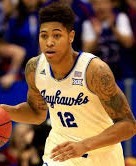
 11. Indiana Pacers – Kelly Oubre, SF, Kansas
11. Indiana Pacers – Kelly Oubre, SF, Kansas
Like many Jayhawks prospects, Oubre should be even better in an NBA system where he’ll have more scoring opportunities. As a rookie, Oubre should be able to hit open jumpers, and if he develops his ball-handling skills to create his own scoring opportunities, he could be very good.
He averaged 9.3 points and 5 rebounds in just 21 minutes per game for Kansas, and went 15-for-19 from the foul line in a late-season victory over TCU.
Oubre is the epitome of a guy whose value could rise and/or fall like a penny stock depending on how he looks in workouts.

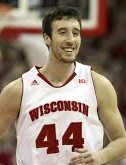 12. Utah Jazz – Frank Kaminsky, C, Wisconsin
12. Utah Jazz – Frank Kaminsky, C, Wisconsin
Kaminsky’s name was everywhere during Wisconsin’s postseason run, and for good reason.
It’s challenging to find legitimate centers with Kaminsky’s skill-set offensively to face up the basket, beat his man off the dribble and even shoot threes (he was 42-for-101 for the Badgers).
Kaminsky does fall in love with standing outside and waiting for the ball. He needs to get stronger in order to handle the grind of playing against stronger opponents, but he is very NBA-ready. The Jazz, fresh off trading Enes Kanter, could use a big like Kaminsky, who can stretch the court and complement Derrick Favors.
With more teams featuring big men that can face up and stretch the court to allow teammates to drive and attack the rim, the Kaminsky selection by Kevin O’Connor makes plenty of sense.
Danny Schayes says Kaminsky reminds him of …. himself.

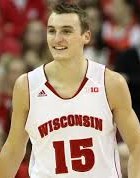 13. Phoenix Suns – Sam Dekker, SF, Wisconsin
13. Phoenix Suns – Sam Dekker, SF, Wisconsin
Dekker became the x-factor for Wisconsin during their run in the Big Dance.
Dekker may not be a conventional three or four in the NBA, but he will be out on the court playing because of his fearless style of play and infectious energy. He does it all: scoring, shooting, rebounding, defending.
Dekker’s biggest weakness right now is a lack of a consistent shooting stroke, but as he becomes more consistent he can play forward in the NBA and match up against a variety of opponents. After making just a third of his 3-point attempts for the Badgers, my hope would be that he is currently shooting 1,000 a day prior to his individual workouts.
Dekker looks and plays like Phoenix coach Jeff Hornacek did and could give the Suns an ridiculously long front court at times with the Morris twins.

 14. Oklahoma City Thunder – Devin Booker, SG, Kentucky
14. Oklahoma City Thunder – Devin Booker, SG, Kentucky
Booker strikes me as a shooting specialist in the NBA. He showcased great touch and range as a freshman. However, fresh off an unbelievable showing at the NBA combine, teams are rethinking Booker’s ceiling and whether he was pigeonholed at Kentucky because of the roster.
Playing on a deep team like Kentucky might have actually helped Booker, as he was more efficient and is prepared for a similar role in the NBA coming off the bench. Ever since James Harden was traded, the Thunder have not had the same mojo and haven’t replaced him with draft picks like Jeremy Lamb or acquisitions like Dion Waiters. Booker is a perfect offensive complement to play between Russell Westbrook and Kevin Durant.
When watching the game tape, Booker seems to lacks the length and explosion you’d want in a starting caliber wing, but there is no denying his combine performance could be an eye opener to teams looking for an under-the-radar prospect who could turn into the next Jimmy Butler.

 15. Atlanta Hawks (From Brooklyn) – Myles Turner, C, Texas
15. Atlanta Hawks (From Brooklyn) – Myles Turner, C, Texas
Turner checks off all the boxes that make scouts and general managers go crazy for big men.
Turner, who our Michael Scotto profiled here, has showcased a nice range and touch on his jumper, the legitimate size needed to play center, good rebounding ability and a nice touch in the post. On the flip side, Turner is not a great athlete, and as the NBA picks up the pace of play, Turner must show he quick enough on his feet to not be a defensive liability.

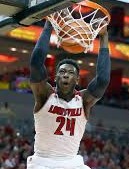 16. Boston Celtics – Montrezl Harrell, PF, Louisville
16. Boston Celtics – Montrezl Harrell, PF, Louisville
Harrell is an imposing physical specimen, there’s no doubt about that. Physical ability often improves your draft stock, but it does not necessarily translate into having or developing a full NBA skill-set.
Since Draymond Green has become the new standard for undersized, versatile forwards, Harrell should be next in line. Standing at 6’8″ with a freakish 7’5″ wingspan, Harrell has teams playing close attention as teams look for the next Green.
Coming from a blue-chip program like Louisville and knowing the ins and outs of playing defense, the biggest questions with Harrell will be his offense and what position he’s best suited for. Watching how Brad Stevens handled his rotation and used players like Jae Crowder, there is no doubt a player of Harrell’s ability can find minutes with him.
He averaged a flashy 16.7 points and 9.3 rebounds for the Cardinals, but his junkyard dog mentality will fit in nicely on a Boston team that played physically against Cleveland in Round 1. One red flag at the draft combine was his body fat percentage, 11.9 percent.

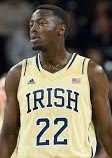 17. Milwaukee Bucks – Jerian Grant, PG, Notre Dame
17. Milwaukee Bucks – Jerian Grant, PG, Notre Dame
Teams will fall in love with Grant during pre-draft workouts.
He’s an intelligent prospect who plays hard and has great length for the point guard position. Grant can even play off the ball at times as he is a solid shooter, but he’s most effective when creating for himself and his teammates.
Blessed with good size and athleticism, teams will look past his mediocre defense. He can be coached up in that area.
He averaged 16.5 points and 6.7 assists per game for a very good Fighting Irish squad that nearly knocked off Kentucky in the Elite Eight. His body fat percentage was a mere 5.6, lower than Kentucky’s Harrison twins.
Anyone who watched the Bucks play the Bulls in the playoffs knows that Jason Kidd still wants a PG who he can trust and would allow Michael Carter-Williams to play more off the ball.

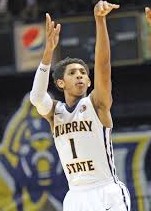 18. Houston Rockets (From New Orleans) – Cameron Payne, PG, Murray State
18. Houston Rockets (From New Orleans) – Cameron Payne, PG, Murray State
Not many players in college average 20.3 points, ranked 11th nationally, and six assists like Payne did as a sophomore.
Payne is a solid shooter who doesn’t ignore getting his teammates involved and has great court vision. Overall, he’s a very productive player with good burst and quickness who could be a great pickup for a team outside of the lottery.
With Patrick Beverley a restricted free agent after the season, the Rockets could be desperate for help at point guard. They find themselves using Pablo Prigioni and Jason Terry at the point during this year’s NBA playoffs with Beverley hurt. Payne measured 6’1″ at the combine with a 6’7″ wingspan.
Payne’s stock is all over the board after an impressive combine, but as he moves up and threatens to be a lottery pick I think he could be a target of a team looking to move up or into the draft.
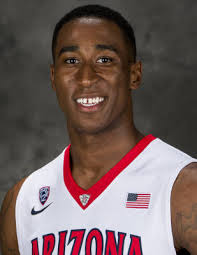
 19. Washington Wizards – Rondae Hollis-Jefferson, SF, Arizona
19. Washington Wizards – Rondae Hollis-Jefferson, SF, Arizona
Hollis-Jefferson is an intriguing prospect who could be a lock-down defender of multiple positions at the NBA level. Hollis-Jefferson recently tweeted that he was looking forward to dunking on Serge Ibaka when he joins the NBA.
Hollis-Jefferson will make his living in the NBA as a defender, but can also finish in transition and rebound pretty well. Due to his lack of offensive skills and polish, Hollis-Jefferson probably slips to a team in the late teens or early 20’s.
Otto Porter’s growth could impact the Wizards’ thinking, but there’s also the fact that Paul Pierce is not getting any younger and sounded uncertain about his future after Washington’s Game 6 loss to Atlanta. Adding Hollis-Jefferson, who could play a Draymond Green-like role and allow Porter to slide over to SF, could help the Wizards improve even if The Truth retires or goes elsewhere.
Porter’s play in the second round will have a major impact on which need the Wizards choose to address in the draft.
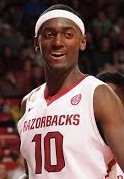
 20. Toronto Raptors – Bobby Portis, PF Arkansas
20. Toronto Raptors – Bobby Portis, PF Arkansas
It’s hard not to look at Portis and see all the potential he has. Several executives I spoke with in Chicago were gushing over Portis and his competitive streak.
Portis has tremendous length and moves well for his size. Combined with the ability to face up and step out beyond the arc, Portis can be an inside-out threat, and we all know how much NBA teams value stretch fours.
In fact, the Raptors probably have more of a need for a stretch-four than any other team in the NBA not named the Knicks. Toronto could have used a player like Portis in their opening round exit to the Wizards.
Portis measured 6’10” and weighed 246 pounds at the combine, but he definitely must get stronger to play in the NBA and be effective rebounding at that level.
CONTINUE READING: PICKS 21-30